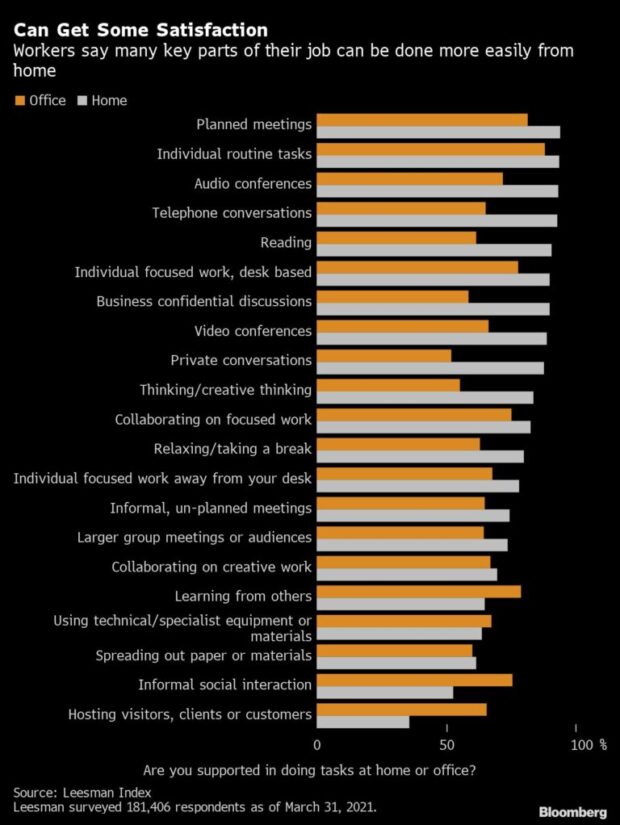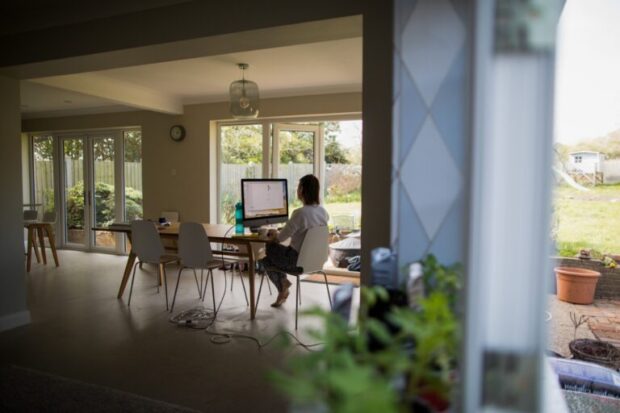Fourteen months after coronavirus confined the world’s office-workers to their homes, companies are embarking on another great experiment — how to get their teams back together, in-person, at least some of the time.
It’s a task that is briefly uniting the titans of global finance and leaders of nimble startups, all of whom are having to plan for staff coming in two or three days each week, at least for now. Driven in some places by COVID concerns and in others by a desire to embrace workplace change, hybrid work is the new center ground — at least in the short term.
But with work-from-home mandates easing soon in many places, experts are concerned the future mix of home and office work will be complicated to manage and won’t provide the flexibility employees have become accustomed to during the pandemic. The UK is expected to ease restrictions on June 21, and New York’s mayor wants the city “fully reopened” by July 1.
“Remote home-working is about flexibility in location, not necessarily about flexibility in hours,” said Claire McCartney, senior resourcing and inclusion adviser at the CIPD, the UK’s professional body for human resources and people development.
Flexible arrangements — ranging from job-sharing to staggered start and finish times or compressed working hours — are used frequently by a range of employees, notably parents and carers, and in by particular working women.
A CIPD analysis of UK labor force data suggests that 9.3% of UK workers — equivalent to 3 million people — would be willing to work fewer hours in exchange for a cut in pay, and in a report published last month, the organization found unmet employee demand across a range of flexible working options.
Yet the CIPD also found that while 63% of employers expect to implement hybrid work policies in 2021, fewer than half (48%) plan to expand “flexitime,” the single most popular flexible-work option.
“A lack of true flexibility is a really valid concern,” said Margarete McGrath, London-based global head of strategic propositions at Dell Technologies Inc. McGrath’s teams work to help clients adapt to a changing business environment while putting in place technology to help them retain and attract staff in the long-run.
For now, many employers are sanguine about the prospect of asking staff to come back to office two or three days a week. The divide is over what executives expect their teams to do when they cross the threshold, and how much permanent change bosses will encourage.
“It could be absolutely chaotic. That’s our fear, that actually they haven’t pulled together a hybrid working strategy,” McGrath said. “There are lots of organizations that are lagging behind, saying ‘we’re not going to change anything, we’re just going to get our staff back in.’ They’re not fully grasping the extent of this paradigm shift around work.”
Data from workplace experience specialists Leesman show that employees feel more productive at home doing many key elements of their jobs. Separately, research carried out at Stanford University demonstrated that home-working works, in moderation.

Peggie Rothe, Leesman’s chief insights & research officer, says not all companies are ready to embrace the findings. She sees a division into three broad buckets: companies that are already taking action and redesigning working practices; some that intend to but haven’t started the process yet; and those that simply have not started thinking about it yet.
A recent King’s College London/Bristol University study found that while 97% of companies are planning for hybrid working of some kind, just 36% plan to redesign job roles.
“The worst thing an organization can do now is close you eyes, cover your ears and imagine you can try to go back to how it was before, because if you do that you’re going to go backwards,” Rothe said.
That’s a concern driving change at Aviva, the insurance company that was an early UK evangelist of hybrid work. Managers there are now being supplied with five profiles to help define where and how their team members are best suited to working and what facilities they will need.
Concerns remain, though, that a focus on role-based guidelines for the new era of work will allow employers to trumpet hybrid working policies while paying lip service to wider issues of flexibility.
Such arrangements help businesses attract and retain employees, as well as supporting inclusion and diversity and boosting customer service, said Claire McCartney of the CIPD. “Organizations will ignore this at their peril, because expectations have changed,” she said.

Experts are concerned the future mix of home and office work will be complicated to manage. Photographer: Chris Ratcliffe/Bloomberg
At Aviva, the onset of the hybrid era will bring a formal end to some of the blurring of family and home life that employers have tolerated during the pandemic. For example, wherever employees are working they will be expected to ensure they have adequate childcare in place to allow them to work uninterrupted.
Emily Clark, a senior employment lawyer at international law firm Bird & Bird LLP in London, believes companies will need to think through potential side-effects of imposing a top-down, one-size-fits-all employment policy.
“The risk is that people’s working patterns are usually set out in their employment contracts to some extent,” said Clark.
“It does get quite complex. I can envisage situations where organizations have something in mind that might not be the normal pattern of working in the office every and people turn around and say ‘You can’t change that without my consent.'”
Dell’s Margarete McGrath notes that companies need to ensure business goals met, premises are COVID-secure and staff are treated fairly.
“It’s important that we get that mix right. There will be teething issues no doubt, because we’re still very much in the experimentation phase.”
By the time schools and universities open their doors in September life on Wall Street will have resumed, and employers in the U.S. and UK will likely have more robust plans. Leaders and staff alike may well find they need to be patient, and strap in for a bumpy road ahead, according to McGrath.
“This is the first time where nobody is bragging that they’ve got this totally pinned down. We’re going through another phase that is even murkier.”
Top photograph: Pedestrians walks in the Canary Wharf business, financial and shopping district of London, on Monday, Sept. 14, 2020. Photo credit: Simon Dawson/Bloomberg





















 Executives on the Move at Liberty Mutual, Cowbell, W. R. Berkley
Executives on the Move at Liberty Mutual, Cowbell, W. R. Berkley  Breaking: Andersen to Replace Zaffino as CEO of AIG on June 1
Breaking: Andersen to Replace Zaffino as CEO of AIG on June 1  NOAA Announces Latest AI-Driven Global Weather Models
NOAA Announces Latest AI-Driven Global Weather Models  Berkshire Hathaway Enters Post-Buffett Era as Share Prices Fall
Berkshire Hathaway Enters Post-Buffett Era as Share Prices Fall 





